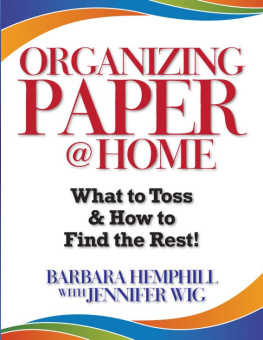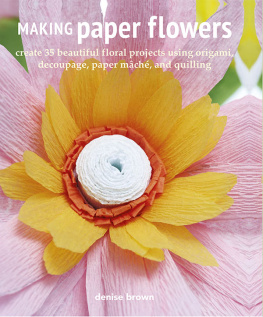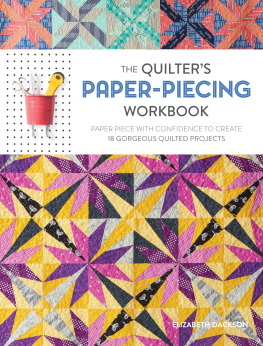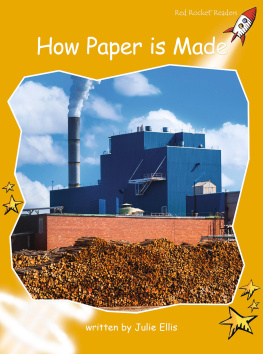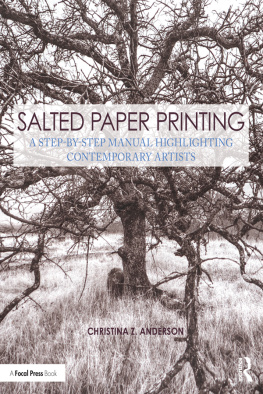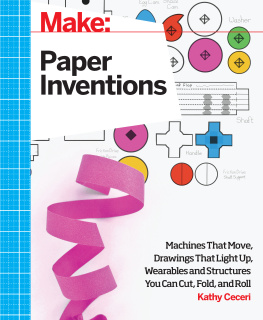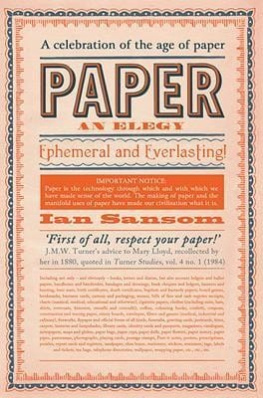Organizing Paper @Home:
What to Toss and How to Find theRest
By Barbara Hemphill
With Jennifer Wig
Published by Barbara Hemphill atSmashwords.
Copyright 2011 BarbaraHemphill
ALL RIGHTS RESERVED. This book containsmaterial protected under International and Federal Copyright Lawsand Treaties. Any unauthorized reprint or use of this material isprohibited. No part of this book may be reproduced or transmittedin any form or by any means, electronic or mechanical, includingphotocopying, recording, or by any information storage andretrieval system without express written permission from the author/ publisher.
*****
Acknowledgements
This book would not have occurredwithout the valuable support of the following people:
My co-author, Jennifer Wig, with whomit has been sheer joy to write this book, and to whom I've giventhe title "Keeper of the Legacy."
My parents, Everett and Doris Frost,who role-modeled the principles that have been the basis of mybusiness for 30+ years.
My husband, Alfred Taylor, who says hisjob is to "block and tackle so you can fly."No words can express mylove and gratitude!
My best friend, Florence Feldman, whotold me 28 years ago "I believe in you," and who helped me launchthe first edition of this book in 1988!
My business partner, Andrea Anderson.We call each other "Peanut Butter" and "Jelly" and those of youwho have worked with us know why!
The CPES (Certified ProductiveEnvironment Specialist) Community, who continually serve asmotivation to keep improving the products and services weoffer.
And of course, the clients andaudiences whom I have had the pleasure to serve since 1978. I amindeed blessed by all of you!
*****
Table of Contents
The Roar of a New Tiger
Roar Right Back
Get Centered
A New Key
Computers and Paper
Paper or Electronic
Sort Short
Master the Art of Wastebasketry
Your Calendar
Your To Do Lists
Your Action Files
Names and Numbers
Your Reference Files
Bills Bills Bills
The Paper Population
The Tax Man Cometh
Your To Read Pile
Your To Write Pile
Family Records
Memorabilia and Photographs
The Kitchen Piles
Children and Paper
Travel and Paper
Paperholics
Caging that Tiger
*****
Introduction
I first shared my dream of writing this book with my lifelongfriend and colleague Florence Feldman in 1981. Her professionalexpertise and personal friendship become more valuable to me as theyears go by.
It is amazing that 23 years have passedsince the first edition of Taming the Paper Tiger was published byDodd, Mead. It is even more amazing that the problem of papercontinues to be the No. 1 organizing challenge in the household!The computer was touted as being the tool to eliminate paper fromour lives and enabled us to be more organized. In many ways, itdid, but it also allowed us to generate more paper than everbefore, and we learned that organizing electronic files has its ownchallenges!
The reality of "paperless" has nothappened, and I personally promote the concept of "almostpaperless" since in some instances, paper is simply a morepractical and/or desirable format. In addition to the fact we havemore paper and more computers, life seems to get more complicatedin every way every day and much of that complexity is reflectedin both realms.
In my continuing experience as aproductivity consultant, I have observed that the principles,practices, and techniques I espoused in the first edition of Tamingthe Paper Tiger are still true: "Only the names have changed," asthe familiar expression states. Hence, it seemed appropriate topublish a new edition of this book designed to be relevant intoday's digital world. One of the key components of my lifephilosophy is "Together We Are Better. With that in mind, Iinvited Jennifer Wig to partner with me in writing this new edition and what a joy it has been. I know that you, the reader, willbenefit too, and my hope is that because of her insight andcontribution, the principles, practices and techniques in this bookwill last another 30 years!
I am especially thankful for the loveand support of my husband, Alfred Taylor, who is the greatest fanclub any writer ever had, and with whom I enjoy my life more everyday. Happy paper organizing!
*****
Chapter One
The Roar of a New Tiger
When I first wrote this book, computerswere just starting to become part of the home office scene and moreoften than not, were creating more paper than they saved. Today, itis completely different. People are lounging on their couches withiPads, making notes and sending emails from their smartphones, andhandling most aspects of their daily lives with the help of acomputer.
Does this sound familiar? You're payingsome bills online at your desk, but you realize you need to save acopy of one of the bills to keep for tax reasons. Didn't you createa file for that purpose? Where is it saved? Medical bills inpaper form are arriving each day from your hospital stay lastyear, with some of them payable online and some must be paid viasnail mail. What to do with that stack of paper and how to organizethat and the electronic files? In the middle of this musing, yourson comes in and asks for a copy of something for school, but theprinter ink is dried up because you're not using it as much. Thenyour cell phone rings, and it's your friend asking if you want togo shopping the 18th. Your electronic calendar tracking both workand home appointments says you're free, but you have the naggingfeeling that you're missing something. Did you write it down on aGmail task list? Or in your handy little "old-fashioned"notebook?
The roar of the paper tiger is everpresent in our daily lives even when our lives are stored incomputer files instead of filing cabinets. Did you know that one oftop requests from Hewlett Packard for any electronic device is theability to print?
A computer is like any other tool: Useit correctly and it can help, but otherwise it's just a largepaperweight of metal and plastic. It can either save you fromwading through paper or create more problems than ever. And as weblend our lives more and more with computers, it can be hard toremember where to find the item you need.
As an organizing consultant, Ive spentthousands of hours working with people and their paper, fromparents struggling with the piles of papers their kids bring homefrom school, to corporate executives responsible for thousands offiles. One fact remains absolutely clear: paper-management skillsare essential to survive the information explosion in oursociety.
A Slow Change
In 1926, a little more than 15,000pieces of mail were sent nationwide. By 2000, we were sending morethan 207.5 billion pieces of mail per year. But now, that figure isdeclining, down to 171 billion in 2010.
Pingdom, a firm that watches the Web,estimates that in 2009, 90 trillion e-mails were sent that's 247billion email messages a day! Those figures are expected to grow.In 2010, the number of people worldwide using email was about 1.9million. That's expected to reach 2.5 billion by 2014, according toRadicati Group, Inc.
Also worth noting: In 2001, spamaccounted for an estimated 5 percent of our email. By 2007, itclogged our inboxes, accounting for 90-95 percent of all emailsent.
People often say they hate paper andthus, they hate dealing with emails and files as well. But ifthat's true, why do they have so much trouble clicking "delete" orgetting rid of it? How many people still print out that importante-mail messageor the information gathered from a great website?Computers have an increasing impact on our lives; learning tomanage the paper and files they generate is essential.
How many emails are sitting in yourinbox? Or in other email folders? Those cute forwards from yoursister-in-law, the reminder to pay your credit card bill, the emailfrom your rental house about your upcoming trip the list justseems to keep growing! It may not be taking up space on yourkitchen counter, but the overwhelming feeling generated by all thatelectronic paper remains.
Next page
